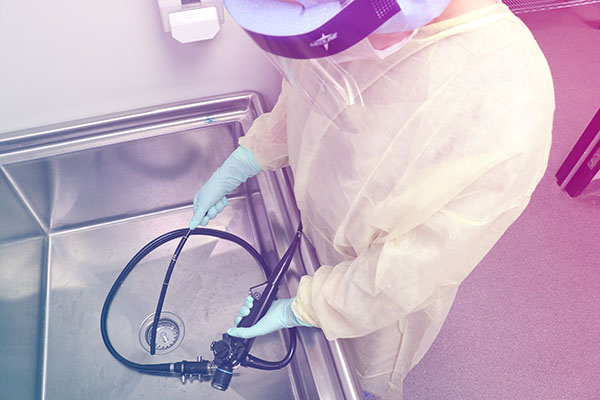Improper endoscope reprocessing has been identified as one of healthcare’s most dangerous technology threats. Additionally, there is considerable room for error. Proper reprocessing of endoscopes and accessories can include anywhere from 50 to 100 steps and takes significant time.
However, ensuring the completion of each step is critical to patient safety. Any digression or improper time-lapse will allow the survival of microorganisms and increase the risk of infection. This could include the presence of biofilm and disease outbreaks which may include multi-drug resistant bacteria.
Human error is often cited to be at fault for the majority of endoscope reprocessing system fail points and cross-contamination. However, research shows that there are some built-in threats that come with the shape and use of scopes. By being aware of medical device complexities and system vulnerabilities and using complementary technology, technicians can mitigate life-threatening risks.
Below are the most common flexible endoscope reprocessing mistakes healthcare staff should be aware of and the top ways to avoid them.
What Are the Most Common Scope Reprocessing Mistakes?
Endoscope reprocessing systems are in place for a reason. These established protocols help prevent the risks of the technology.
While there are up to 100 essential protocol steps, here are the 5 most common mistakes technicians should be aware of:
- Mishandled scopes during transport.
An often overlooked fail point is mishandled scopes from endoscopy or the operating room (OR) to decontamination. In accordance with ANSI/AAMI ST90 Processing of Healthcare Products — quality management systems for reprocessing in healthcare facilities, flexible endoscopes should be transported in containers that meet the requirements for transporting hazardous items and should be:
– puncture resistant
– labeled hazardous
– have leak-proof sides and bottoms
The endoscope should also be laid in the basin allowing it to naturally coil in large loops to prevent breaks. It’s critical that the scope not be stacked with other scopes or with instrument sets when being transported. Stacking scopes risks damaging vulnerable and expensive scope parts such as cameras (which are often 3D and color-enabled) and channel bends. Not only are these damages costly; damages to these parts create risks for hospitals and patients. - Failure or improper manual cleaning (especially of channels).
More facilities are moving away from manually soaking flexible endoscopes. Automated endoscope reprocessors (AERs) are the new standard for endoscope cleaning. However, even though AERs augment cleaning, they do not negate manual cleaning procedures. Techs should pay particular attention to channels of flexible endoscopes as they are especially vulnerable and are often improperly cleaned. For example, forgetting to brush and then flush the channels is critical. While manual cleaning is time-consuming for each scope, it’s not something that can be rushed. - Failure to replace endoscope accessories.
Flexible endoscopes are relatively fragile and should be inspected regularly. Accessories are often overlooked but should also be assessed frequently. Air or water channel bottles and tubes, angulation adjustment, and air/water nozzles are commonly in need of repair or replacement. Tracking technology such as ScopeTrac® Advanced should be used in these instances to keep accurate inventory repair records. - Using incorrect connections or not securing connections.
Scopes and their accessories must be connected securely and tightly. Failure to securely connect hoses, for example, will cause a failure when you start the machine. Some older machines don’t have the safety features that guarantee you have the correct connector, so education and training for techs on proper connection procedures are critical. - Be aware of shelf-life/hangtime protocol.
The drying and storage of flexible endoscope reprocessing is an area of growing concern. The proper drying of endoscopes prior to storage is a common step that is often missed. Recent research shows that 95% of stored, patient-ready scopes retained residual liquid after automated endoscope reprocessing.
Tips to Avoid Reprocessing Risks
With each scope requiring time-consuming manual cleaning and some healthcare facilities performing up to 40 procedures a day with only a few scopes, it makes for a long day. But there’s no room for shortcuts. So what’s the solution? Here are a couple of our top tips to mitigate risk in scope reprocessing.
- Tune into visual oversight as the first line of defense. That way you can identify any damages immediately and don’t risk patient safety with broken or missing parts or accessories. The second piece to this is reporting these damages in a master database. Techs should be able to easily request a repair for a damaged scope in their tracking system.
- We don’t mean to overstate the obvious but don’t rush. Mishandled transportation of devices, such as rushed manual cleaning and incorrect connections carries high risk. These processes cannot be rushed.
- Invest in processes and smart products that support technicians. The majority of literature and incident reports blame the reprocessing technicians for contamination issues. However, studies have found that endoscopes remain contaminated despite reports of close adherence to reprocessing procedures. That doesn’t mean that we give up on the strict protocol procedures. It does mean that something is wrong with tracking and reporting. The solution lies in providing technicians with monitoring products and processes that aid in documentation, reporting, and inventory management.
Tools such as ScopeTrac Advanced® allow technicians to track every endoscope and its accessories through the entire procedural cycle. They offer guided workflows and quick instructions for use (IFU) access. Technicians can also record detailed reprocessing steps, notes, and search for scopes in the database by model and serial number.
By adding intuitive electronic tracking systems to flexible endoscope reprocessing, your team can help avoid fail points altogether, optimize workflows, and improve inventory management.
Sterile processing staff shouldn’t have to carry all the weight on their shoulders in this high-demand healthcare environment. Learn more about electronic monitoring processes and products for safe endoscope reprocessing systems.


